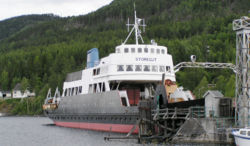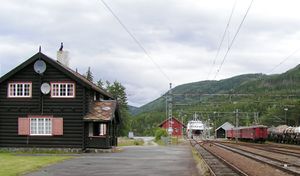Tinnosbanen
| Tinnosbanen | |

| |
|---|---|
| The railway ferry M/F Storegut at Tinnoset | |
| Info | |
| Type | Railway |
| Status | Heritage |
| Start station | Notodden |
| End station | Tinnos |
| No. of stations | 7 |
| Operation | |
| Opened | 1909 |
| Closed | 1991 |
| Owner | Norges Statsbaner |
| Operator(s) | Norges Statsbaner |
| Character | Freight |
| Technical | |
| Line length | 34 km |
| No. of tracks | 1 |
| Gauge | 1,435 mm (4 ft 8½ in) |
| Electrified | 15 kV 16⅔ Hz AC |
Tinnosbanen was a 30 km Norwegian railway line that went from Tinnoset to Notodden in Telemark. The railway was part of the transport chain used to transport fertilizer from Norsk Hydro's factory in Rjukan to the harbour in Skien. The railway opened in 1909 and was closed when the plant closed in 1991. The railway is sometimes mistakenly believed to be part of Rjukanbanen.
The railways starts in the north at the mouth of the lake Tinnsjø where the railway ferries arrived from Mæl. The railway continued south from Notodden along Bratsbergbanen. The transport chain from Rjukan to Skien consisted of four sections:
- Rjukanbanen, railway line from Rjukan to Rollag (Mæl), 16 km
- Tinnsjø railway ferry from Rollag to Tinnoset, 30 km
- Tinnosbanen from Tinnoset to Notodden, 34 km
- Telemark canal from Notodden to Skien, 54 km with barge
- In 1919 the canal was replaced with the railway Bratsbergbanen from Notodden to Skien. [1]
Contents
History
Norsk Hydro was founded in 1905 by Sam Eyde as a Norwegian fertilizer manufacturer, and the first factory was opened in Notodden. Fertilizer factories need a lot of energy, and then it was necessary to locate the plants near hydroelectric power plants, and at Rjukan there was a large waterfall. In 1911 Rjukan Salpeterfabrikk was opened. [2]
Tinnosbanen was opened in 1909 as a standard gauge (1435 mm) railway along with Rjukanbanen and the railway ferry service, and was the second railway line in Norway, after Thamshavnbanen, to be electrified in 1911. The railway service utilised Telemark Canal until 1919 when Bratsbergbanen opened from Notodden to Skien. The railway was used both to transport raw materials to the factory and to transport the finished fertilizer to the harbor at Skien. There was also passenger trains that ran.
In 1912 the state bought Tinnosbanen from Norsk Hydro, and started construction of a new railway from Notodden to Skien, to replace the canal barges, with the railway being completed in 1916. Norges Statsbaner took over the railway operations in 1920 when the new railway from Notodden to Kongsberg was completed. [3]
The railway ferry service was provided by four different ships, D/F Rjukanfoss, D/F Hydro (1919), D/F Ammonia (1929) and M/F Storegut (1956). The three first were steam ships, and the latter two are still anchored at Mæl. The service was the only ever railway ferry service on a lake in Norway, and D/F Ammonia is the only remaining railway ferry steam ship in the world.[4] In 1944, during World War II, D/F Hydro was the target of the Norwegian heavy water sabotage, when the ferry was sunk to 430 meters deep in Tinnsjø to prevent Nazi Germany from developing nuclear weapons.[5]
In 1929 Norsk Hydro also establish itself at Herøya in Porsgrunn, and in 1991 the factory in Rjukan, and therefore also the railway line, was closed. The passenger trains, operated by Norges Statsbaner, had been discontinued already in 1985. In 1997 the ownership of the track was transferred to Stiftelsen Rjukanbanen, a foundation that started heritage operation of the line in 1999.
Stations
- Notodden Old
- Notodden New
- Lisleherad
- Grønvollfoss
- Årlifoss
- Gransherad
- Tinnoset
References
- ↑ Maana Forlag. Fakta om Rjukanbanen (Norwegian). Retrieved on 2006-12-12.
- ↑ Norsk Hydro. The next gigantic step. Retrieved on 2006-12-12.
- ↑ Helge Nisi. Tinnoset (Norwegian). Retrieved on 2006-12-13.
- ↑ Maana Forlag. Fakta om Rjukanbanen (Norwegian). Retrieved on 2006-12-12.
- ↑ Rjukan Tourist Office. Rjukanbanen (Norwegian). Retrieved on 2006-12-12.
External links
| Wikimedia Commons has media related to: Rjukanbanen |
- Stiftelsen Rjukanbanen
- Web site on Rjukanbanen and Tinnosbanen
- Private web site with focus on ferries on Tinnsjø


